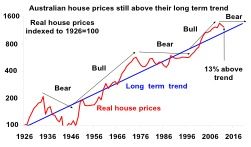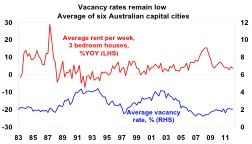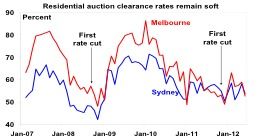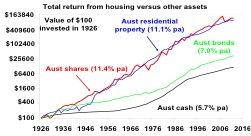Key points
- Australian housing is still overvalued, leaving it, banks & the broader economy somewhat vulnerable. Undersupply provides some support but the two key threats are a Chinese hard landing and selling by investors.
- The most likely scenario is many years of range bound house prices around a flat trend in real terms.
- Right now house prices may slip a further 3% or so in the short term but lower mortgage rates are likely to lead to a bounce in prices from later this year/early next year.
Introduction
After the surge in Australian house prices from the mid 1990s into last decade my view was that while the risks of a sharp fall back in house prices were high, the most likely scenario was an extended period of range bound house prices in real terms. If anything most of the surprise has been on the upside – although not by much in real terms. But
despite the fears of many, house prices have not plunged like those in the US and elsewhere, despite a bigger boom.

However, the risks are rising again. Prices have slid 6% since their 2010 high and worries that the GFC is about to finally catch up with Australian housing are on the rise again. Excessive house prices and the excessive level of household debt that has come with it are Australia’s Achilles heal. Housing is 60% of household wealth and so movements
in house prices have a big impact on household financial well being and spending. Housing credit also amounts to 59% of total private credit so what happens to house prices is critically important to Australian banks. And as we have seen in Ireland and now Spain, what happens to banks can have a big impact on public debt levels.
Still overvalued, but not by as much
The bad news is Australian housing is still way overvalued. The good news is it is less so, with real house prices going nowhere for the last four years:
- According to the OECD, the ratio of house prices to incomes in Australia is 28% above its long term average, putting it at the top end of OECD countries, although several other countries are more extreme. The US is now
below its long term average on this measure.

- According to the 2012 Demographia International Housing Affordability Survey, Australian housing trades on a median multiple of house prices to annual household income which is double that of the US. In Sydney, median house prices are $637,600 compared to $324,800 in Los Angeles. In Perth they are $450,000 compared to $159,500 in Houston, Texas.
- However, it is apparent in the next chart that while real house prices are still above their long term trend, the divergence has narrowed to 13% from a peak of 33%.
Real house prices have now fallen back to 2008 levels.

- Another way of looking at property valuations is to look at the ratio of price to rents (sometimes referred to as a PE ratio for housing) and adjust for inflation. On this basis Australian housing is still overvalued relative to its long term average by 10%, but at least this is down from a peak overvaluation of 38% in 2003.
The bottom line is while it may not be as stretched as was the case a few years ago, Australian housing is still overvalued. This combined with still high household debt to
income ratios leaves Australia vulnerable. Still undersupplied, but maybe not as much
One of the big supports for the Australian housing market is thought to be a shortage of housing with the National Housing Supply Council estimating a cumulative shortfall of
more than 200,000 dwellings. However, the just released 2011 ABS census wiped almost 300,000 off previous population estimates suggesting that the undersupply may not be as chronic as thought, and along with slowing population growth, has potentially reduced a support for house prices. Our assessment though is that while the undersupply of housing may not be as severe as thought, low vacancy rates still attest to some undersupply. And
Australia has not had anything like the residential property construction boom that the US had last decade, which accentuated the downwards pressure on its house prices. In Australia, housing starts and approvals are at cycle lows.

Where to from here?
Right now the Australian residential property market is chronically weak. Finance approvals & new home sales are depressed, first home buyer activity is subdued, prices are down, listings are up and auction clearance rates have been weak for 18 months. In fact, the failure of timely data like auction clearances to spring back into life despite mortgage rates starting to fall 8 months ago is a sign of how weak things are. Since the GFC, Australians have become fearful of taking on more debt and the once strongly held belief that house prices can only go up has long been ditched.

However, while fears are growing of a deep house price slump ahead, the most likely scenario remains a lengthy period of range bound house prices around a flat trend in
real terms. Just as we have seen nationally over the last few years and in Sydney since 2003. Essentially poor affordability, overvaluation and high household debt levels have put a cap on house prices whereas undersupply should limit their downside, within which, prices will cycle up and down in lagged response to falls and rises mortgage rates.
Australia did not experience the same deterioration in lending standards that occurred in other countries last decade. Home ownership rates didn’t increase. Most of the increase in mortgage debt went to older and wealthier Australians better able to service loans. And this has all been reflected in still low arrears rates of around 0.6%, and something like 50% of borrowers being ahead on payments.
Nevertheless, there are two key threats. First, a hard landing in China, resulting in a collapse in export earnings could drive unemployment sharply higher threatening a sharp risein delinquencies and forced sales. However, while this risk has increased given the threat from Europe, a sustained hard landing in China seems unlikely given China’s low
tolerance for social unrest and falling Chinese inflation.
Second, property investors who make up a third of housing debt may loose patience with the lack of capital growth and sell, leading to sharp falls in house prices. However, while it’s hard to see investors piling into residential property now, why would those who are already in suddenly sell now? Real estate investors are usually in there for the long term, made necessary by large transaction costs.
A third threat was coming from interest rates but with rates falling since last November, this has turned into a positive for the housing market. Affordability is still poor, but at least it’s improving and our assessment is that a further improvement in affordability lies ahead as interest rates are likely to fall another 0.75% by year end.
Bottom line – in the very short term house prices could fall a bit further as economic uncertainty continues to impact, but providing Europe doesn’t plunge China and the world into a renewed recession, falling mortgage rates are likely to drive a cyclical recovery in the housing market from later this year/early next. However, the most likely profile over the next 5 to ten years is for house prices to be stuck in a 10% or so range around a broadly flat trend in real house prices.
This is consistent with the 10-20 year pattern of alternating long term bull & bear phases seen in real Australian house prices since the 1920s. See third chart on page 1. The long
term bull phase of Australian house prices that started in the mid 1990s is now giving way to a long term bear phase.
Housing as an investment
After allowing for costs, residential property has historically provided a similar return over the long term to shares. This can be seen in the next chart, which shows an estimate of
the long term return from housing, shares, bonds and cash.

Since the 1920s, housing has returned 11.1% pa after allowing for capital growth and rents and shares have returned 11.4% pa after allowing for capital growth and dividends. While housing is less volatile than shares and for many seems safer, it offers a lower level of liquidity and diversification. Once the similar returns of housing and shares are allowed for there is a case for both in investors’ portfolios over the long term. Right now though, housing looks somewhat less attractive continuing to offer much lower yields. The gross rental yield on housing is around 3.7%, compared to yields of 7% on unlisted commercial
property, 6% for listed property (or A-REITs) and 6.5% for Australian shares (with franking credits). So for an investor, these other assets represent much better value.
This information is of a general nature only and neither represents nor is intended to be personal advice on any particular matter. We strongly suggest that no person should act specifically on the basis of the information contained herein, but should obtain appropriate professional advice based upon their own personal circumstances including personal financial advice from a licensed financial adviser and legal advice. RI Advice Group Pty Limited ABN 23 001 774 125 AFSL 238 429.
